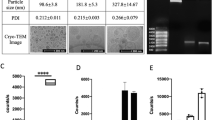Abstract.
In this study, we used a steroid-induced promoter activation system as a molecular switch to study the exogenous activation of transgene expression. This promoter activation system consists of three components: (1) a steroidal inducer drug, mifepristone (RU486), which binds to (2) a chimeric transcription factor complex, consisting of the mutant human progesterone receptor fused to the yeast GAL4 DNA-binding domain and the activation domain of the herpes simplex virus protein VP16, and (3) a synthetic promoter, consisting of a series of GAL4 recognition sequences upstream of the adenovirus major late E1B TATA box, linked to a gene construct (ruc-gfp) encoding a Renilla luciferase-Aequorea green fluorescent protein (GFP) fusion protein. Transcription of the promoter-marker gene cassette is activated by the drug (mifepristone)-bound chimeric transcription factor complex. Monitoring of induced gene expression was carried out using a low-light video camera and a UV microscope to detect luciferase and GFP, respectively. Using this activation system, we observed a 10- to 25-fold activation, depending on the inducer dose, of both luciferase and GFP expression in transiently transfected cells in comparison to cells that were not exposed to mifepristone. We further demonstrated activation of gene expression from the promoter activation system in live animals. The plasmids PAP CMV-GL914VPc'SV, carrying the chimeric transcription factor cassette, and plasmid p17×4-TATA-ruc-gfp, carrying the ruc-gfp reporter gene construct, were co-injected into limb muscles of nude mice. Following DNA injection, mifepristone (50 µg/kg) was delivered by intraperitoneal injection. Thirty-six hours after DNA and mifepristone injection, significant Renilla luciferase activity was detectable in the limb muscles. The promoter activation system was also demonstrated in limb muscles and livers of nude mice that had received transplants of ex vivo-modified cells, which were transiently transformed with both the chimeric activator plasmid and the ruc-gfp reporter plasmid prior to implantation. Significant Renilla activity and GFP fluorescence were detected externally in limb muscles and in the livers of anesthetized animals that had received an intraperitoneal injection of inducer. This external monitoring method for observing inducible gene expression in live animals will facilitate experimental studies of fundamental questions of biological and therapeutic relevance. It will be especially valuable for the analysis of gene function at specific stages of animal development. The method should also be of general use in gene therapy, since it permits simultaneous monitoring of the expression levels of light-emitting proteins and therapeutic proteins originating from the activation of identical promoters.
Similar content being viewed by others
Author information
Authors and Affiliations
Additional information
Electronic Publication
Rights and permissions
About this article
Cite this article
Yu, .Y., Szalay, .A. A Renilla luciferase-Aequorea GFP (ruc-gfp) fusion gene construct permits real-time detection of promoter activation by exogenously administered mifepristone in vivo. Mol Gen Genomics 268, 169–178 (2002). https://doi.org/10.1007/s00438-002-0750-x
Received:
Accepted:
Issue Date:
DOI: https://doi.org/10.1007/s00438-002-0750-x




